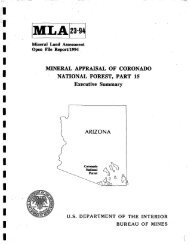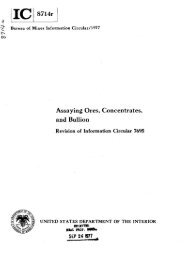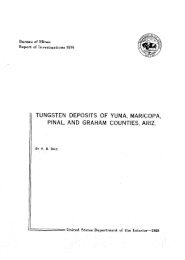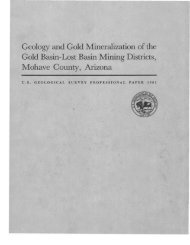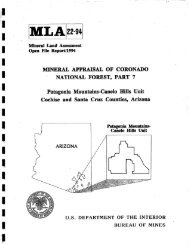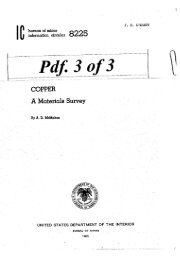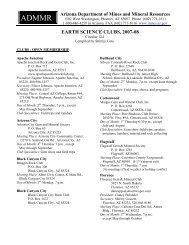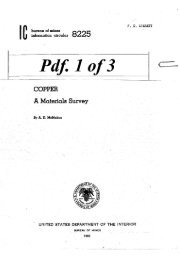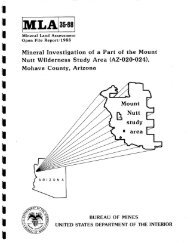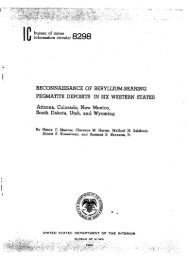here - State of Arizona Department of Mines and Mineral Resources
here - State of Arizona Department of Mines and Mineral Resources
here - State of Arizona Department of Mines and Mineral Resources
You also want an ePaper? Increase the reach of your titles
YUMPU automatically turns print PDFs into web optimized ePapers that Google loves.
WASHINGTON<br />
150.----...,....------r------.-------,-----.....,...-----.-----,-------.--..,<br />
125<br />
100<br />
50<br />
Chelan Lake,<br />
_ Republic, <strong>and</strong> Wenatchee-I:" j,nn·-"Oo!<br />
districts<br />
FIGURE 27.-Annual gold production <strong>of</strong> Washington, 1881-1965. Sources <strong>of</strong> data: 1881-1923 from U.S. Geological Surve:r<br />
(1883-1924); 1924-65 from U.S. Bureau <strong>of</strong> <strong>Mines</strong> (1925-34, 1933-66). Production for 1957-65 includes some fron'<br />
Pennsylvania. Production reported in dollar value was converted to ounces at prevailing price per ounce.<br />
1855, prospectors were active in the Colville district<br />
although the first discoveries were not made until<br />
1883. In 1855, small placers were found along the Columbia<br />
<strong>and</strong> Pend Oreille Rivers. From the 1850's<br />
through the 1880's, placers were worked along<br />
streams in Okanogan, Whatcom, Chelan, <strong>and</strong> Kittitas<br />
Counties <strong>and</strong> along the major streams <strong>of</strong> the <strong>State</strong>the<br />
Columbia <strong>and</strong> Snake Rivers. By 1900, however,<br />
most <strong>of</strong> the placer deposits were exhausted.<br />
Important lode discoveries were made in the early<br />
1870's <strong>and</strong> as the placers were mined out, the lode<br />
mines became the chief producers. The Republic district<br />
in Ferry County is the major lode gold district<br />
in the <strong>State</strong> (fig. 28). Other important lode districts<br />
are the Wenatchee, Blewett, Mount Baker, Monte<br />
Cristo, Slate Creek, <strong>and</strong> Oroville-Nighthawk. A significant<br />
contributor to the gold output in recent years<br />
was the Holden mine in the Chelan Lake district,<br />
Chelan County, w<strong>here</strong> gold was produced as a byp-<br />
196"<br />
roduct from copper ores. This mine, however, \I'as<br />
closed, probably permanently, in 1957 (A. E. WE.issenborn,<br />
written commun., 1962).<br />
Total gold production for the <strong>State</strong> from 1fll0<br />
through 1956 was 2,844,331 ounces (U.S. Bureau <strong>of</strong><br />
<strong>Mines</strong>, 1956, p. 1204). Production figures for the<br />
period 1957-65 include some production from Pennsylvania<br />
<strong>and</strong> t<strong>here</strong>fore are too high by an uncertain<br />
amount, probably a few thous<strong>and</strong> ounces. In the data<br />
presented in the succeeding pages, a total gold p"oduction<br />
<strong>of</strong> only about 2,300,000 ounces is indicated.<br />
The reason for the discrepancy is in the different eE't.imates<br />
by various authors for unrecorded production<br />
before 1900, especially for the period 1860-66, during<br />
which the <strong>State</strong> produced $9 million in gold (Huntting,<br />
1955, p. 33). Most <strong>of</strong> the gold produced before<br />
1900 was from placers, but only 2 percent <strong>of</strong> the to+al<br />
from 1900 to 1952 was from them (Huntting, 1955, p.<br />
32).



